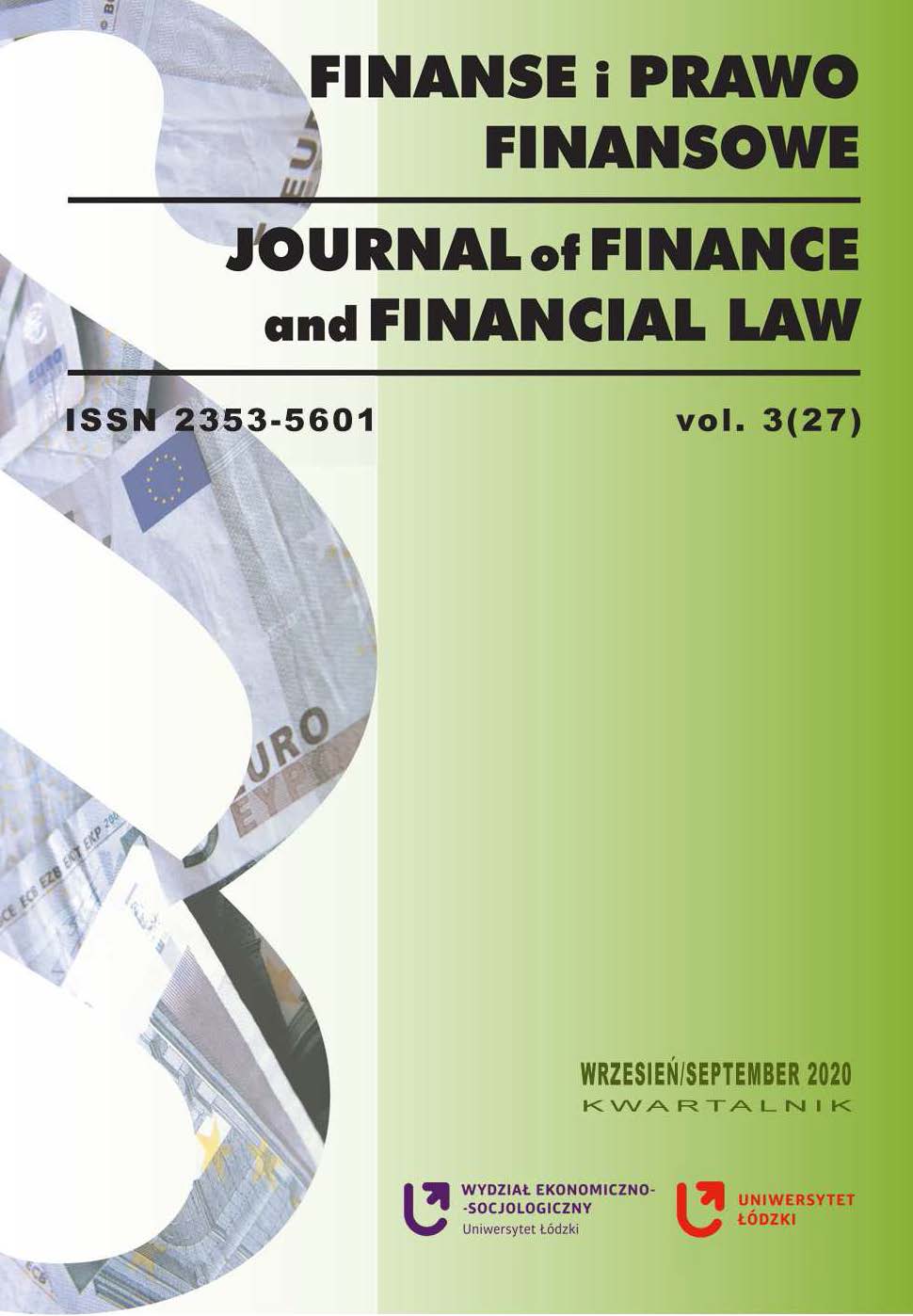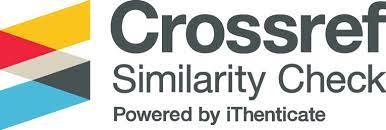Calculating Hurst Exponent with the Use of the Siroky Method in Developed and Emerging Markets
DOI:
https://doi.org/10.18778/2391-6478.3.27.02Słowa kluczowe:
Hurst exponent, market efficiency, developed countriesAbstrakt
The purpose of the article This paper analysis Hurst exponents calculated with the use of the Siroky method in two time intervals of 625 (H625) and 1250 (H1260) sessions for the following assets: (the number of assets for a given group in brackets): Stock indices (74), currency pairs divided into segments: USD exchange rate in relation to 42 other currencies (USDXXX), EURO exchange rate in relation to 41 other currencies (EURXXX), JPY exchange rate in relation to 40 other currencies (JPYXXX) and other currency pairs (12). In total, 209 financial instruments were analyzed.
Methodology: Hurst coefficient calculation with the use of the following methods; Siroky, Detrended Moving Average (DMA) and Detrended Fluctuation Analysis (DFA).
Results of the research: The Hurst coefficient values calculated with the use of Siroky method are similar to the results obtained using DFA and DMA methods. The second main conclusion that was drawn from the research may be formulated as follows: exchange rates calculated for the developed-developed country currencies are more effective than in the case of the developed-emerging countries group.
Pobrania
Bibliografia
Abry P., Veitch D., 1998, Wavelet Analysis Of Long-Range Dependent Traffic, „IEEE/ACM Transactions Information Theory”, vol. 1(44).
Google Scholar
DOI: https://doi.org/10.1109/18.650984
Alessio E., Carbone A., Castelli G., Frappietro V., 2002, Second-Order Moving Average And Scaling Of Stochastic Time Series, „European Physical Journal”, vol. 2(27).
Google Scholar
DOI: https://doi.org/10.1140/epjb/e20020150
Alvarez-Ramirez J., Alvarez J., Rodriguez E., Fernandez A., 2008, Time-Varying Hurst Exponent For Us Stock Markets, „Physica A”, vol. 24.
Google Scholar
DOI: https://doi.org/10.1016/j.physa.2008.06.056
Alvarez-Ramirez J., Cisneros M., Ibarra-Valdez C., Soriano A., 2002, Multifractal Hurst Analysis Of Crude Oil Prices, „Physica A”, vol. 313.
Google Scholar
DOI: https://doi.org/10.1016/S0378-4371(02)00985-8
Barkoulas J., Baum C., 1996, Long-Term Dependence In Stock Returns, „Economics Letters”, vol. 53.
Google Scholar
DOI: https://doi.org/10.1016/S0165-1765(96)00935-4
Barkoulas J., Labys W., Onochie J., 1997, Fractional Dynamics In International Commodity Prices, „Journal of Futures Markets”, vol. 17(2).
Google Scholar
DOI: https://doi.org/10.1002/(SICI)1096-9934(199704)17:2<161::AID-FUT2>3.0.CO;2-H
Barunik J., Kristoufek L., 2010, On Hurst Exponent Estimation Under Heavy-Tailed Distributions, „Physica A”, vol. 389.
Google Scholar
DOI: https://doi.org/10.1016/j.physa.2010.05.025
Batten J., Ellis C., Fetherston T., 2003, Return Anomalies On The Nikkei: Are They Statistical Illusions?, http://ssrn.com/abstract=396680 [access 12.03.2020].
Google Scholar
DOI: https://doi.org/10.2139/ssrn.396680
Berg L., Lyhagen J., 1996, Short And Long Run Dependence In Swedish Stock Returns, http://ssrn.com/abstract=2270 [access 12.03.2020].
Google Scholar
DOI: https://doi.org/10.2139/ssrn.2270
Bunde A., Havlin S., 1995, A brief introduction to fractal geometry, [in] A. Bunde, S. Havlin [ed.], Fractal and disordered systems, Springer-Verlag, Berlin.
Google Scholar
DOI: https://doi.org/10.1007/978-3-642-84868-1
Cajueiro D., Tabak B., 2004a, Ranking Efficiency For Emerging Markets, „Chaos, Solitons and Fractals”, vol. 22.
Google Scholar
DOI: https://doi.org/10.1016/j.chaos.2004.02.005
Cajueiro D., Tabak B., 2004b, The Hurst Exponent Over Time: Testing The Assertion That The Emerging Markets Are Becoming More Efficient, „Physica A”.
Google Scholar
DOI: https://doi.org/10.1016/j.physa.2003.12.031
Cajueiro D., Tabak B., 2005, Ranking Efficiency For Emerging Markets II, „Chaos, Solitons and Fractals”, vol. 23.
Google Scholar
DOI: https://doi.org/10.1016/j.chaos.2004.05.009
Caporale G., Gil_Alana L., Plastun A., Makarnko L., 2016, Long Memory In The Ukrainian Stock Market And Financial Crises, „Journal of Economics and Finance”, vol. 40.
Google Scholar
DOI: https://doi.org/10.1007/s12197-014-9299-x
Caporale G., Gil-Alana L., Plastun A., 2018, Is Market Fear Persistent? A Long-Memory Analysis, „Finance Research Letters”, vol. 27.
Google Scholar
DOI: https://doi.org/10.1016/j.frl.2018.02.007
Caraiani P., 2012, Evidence Of Multifractality From Emerging European Stock Markets, „PLoS ONE”, vol. 7, e40693.
Google Scholar
DOI: https://doi.org/10.1371/journal.pone.0040693
Cheung Y., Lai K., 1995, A Search For Long-Range Dependence In International Stock Market Returns, „Journal of International Money and Finance”, vol. 14(4).
Google Scholar
DOI: https://doi.org/10.1016/0261-5606(95)93616-U
Chow K., Ming-Shium P., Ryoichi S., 1996, On The Long-Run Or Short-Term Dependence In Stock Prices: Evidence From International Stock Markets, „Review of Quantitative Finance and Accounting”, vol. 6(2).
Google Scholar
DOI: https://doi.org/10.1007/BF00367503
Corazza M., Malliaris A., 2002, Multifractality In Foreign Currency Markets, „Multinational Finance Journal”, vol. 6.
Google Scholar
DOI: https://doi.org/10.17578/6-2-1
Costa R, Vasconcelos G., 2003, Long-Range Correlations And Nonstationarity In The Brazilian Stock Market, „Physica A”, vol. 329(1–2).
Google Scholar
DOI: https://doi.org/10.1016/S0378-4371(03)00607-1
Crato N., Ray B., 1999, Memory in returns and volatilities of commodity futures’ contracts, http://citeseerx.ist.psu.edu/viewdoc/summary?doi=10.1.1.42.6774 [access 12.03.2020].
Google Scholar
Czarnecka A., Wilimowska Z., 2018, Hurst exponent as a risk measurement on the capital market, [in] J. Świątek, L. Borzemski, Z. Wilimowska, Information Systems Architecture and Technology: Proceedings of 38th International Conference on Information Systems Architecture and Technology, ISAT 2017, 2018. Pt. 2,Springer International Publishing, Warszawa.
Google Scholar
DOI: https://doi.org/10.1007/978-3-319-67229-8_32
Da Silva S., Matsushita R., Gleria I., Figueiredo A., 2007, Hurst Exponents, Power Laws, And Efficiency In The Brazilian Foreign Exchange Market, „Economics Bulletin”, vol. 7(1).
Google Scholar
Di Matteo T., Aste T., Dacorogna M., 2003, Scaling Behaviors Indifferently Developed Markets, „Physica A”, vol. 324.
Google Scholar
DOI: https://doi.org/10.1016/S0378-4371(02)01996-9
Dominique C., Rivera S., 2011, Mixed Fractional Brownian Motion, Short And Long-Term Dependence And Economic Conditions: The Case Of The S&P 500 Index, „International Business Management”, vol. 3.
Google Scholar
Domino K., 2011, The Use Of The Hurst Exponent To Predict Changes In Trend On The Warsaw Stock Exchange, „Physica A”, vol. 390.
Google Scholar
DOI: https://doi.org/10.1016/j.physa.2010.04.015
Ehlers J., 2005, Fractal Adaptive Moving Average, „Technical Analysis of Stock & Commodities”, vol. 10(23).
Google Scholar
Ehlers J., Way R., 2010, Fractal Dimension As A Market Mode Sensor, „Technical Analysis of Stock & Commodities”, vol. 6(28).
Google Scholar
Einstein A., 1908, Elementare theorie der Brownschen bewungen, „Zeitschrift für Elektrochemie und angewandte physikalische Chemie”, vol. 14(50).
Google Scholar
DOI: https://doi.org/10.1002/bbpc.19080145017
Ferreira P., 2018, Long-Range Dependence Of Eastern-European Stock Markets: A Dynamic Detrended Analysis, „Physica A”, vol. 505.
Google Scholar
DOI: https://doi.org/10.1016/j.physa.2018.03.088
Glenn L., 2007, On Randomness And The NASDAQ Composite”, Working Paper, http://ssrn.com/abstract=1124991 [access 12.03.2020].
Google Scholar
DOI: https://doi.org/10.2139/ssrn.1124991
Granger C., Ding Z., 1995, Some Properties Of Absolute Returns, A Alternative Measure Of Risk, „Annales d’Economie et de Statistique”, vol. 40.
Google Scholar
DOI: https://doi.org/10.2307/20076016
Granger C., Hyungh H., 2004, Occasional Structural Breaks And Long Memory With An Application To S&P 500 Absolute Stock Returns, „Journal of Empirical Finance”, vol. 11.
Google Scholar
DOI: https://doi.org/10.1016/j.jempfin.2003.03.001
Greene M., Fielitz B., 1977, Long-term dependence in common stock returns, „Journal of Financial Economics”, vol. 4.
Google Scholar
DOI: https://doi.org/10.1016/0304-405X(77)90006-X
Henry O., 2002, Long Memory In Stock Returns, Some International Evidence, „Applied Financial Economics”, vol. 12.
Google Scholar
DOI: https://doi.org/10.1080/09603100010025733
Hiemstra C., Jones D., 1997, Another Look At Long Memory In Common Stock Returns, „Journal of Empirical Finance”, vol. 4(4).
Google Scholar
DOI: https://doi.org/10.1016/S0927-5398(96)00016-3
Hja S., Lin Y., 2007, R S Analysis Of China Securities Markets, „Tsinghua Science and Technology”, vol. 8(5).
Google Scholar
Huang B., Yang C., 1999, An Examination Of Long-Term Memory Using The Intraday Stock Returns, Working Paper, Clarion University of Pennsylvania.
Google Scholar
Hurst H., 1951, Long Term Storage Capacity Of Reservoirs, „Transactions of American Society of Civil Engineers”, vol. 116.
Google Scholar
DOI: https://doi.org/10.1061/TACEAT.0006518
Jacobsen B., 1995, Are Stock Returns Long Term Dependent? Some Empirical Evidence, „Journal of International Financial Markets, Institutions and Money”, vol. 5(2/3).
Google Scholar
Jagric T., Podobnik K., Kolanovic M., 2005, Does The Efficient Market Hypothesis Hold? Evidence From Six Transition Economies, „Ester European Economics”, vol. 43.
Google Scholar
DOI: https://doi.org/10.1080/00128775.2005.11041112
Jud S., 2017, Conquering The Seven Faces Of Risk, FinTech Press, Seattle.
Google Scholar
Kale M., Butar F., 2011, Fractal Analysis Of Time Series And Distribution Properties Of Hurst Exponent, „Journal of Mathematical Sciences & Mathematics Education”, vol. 5(1).
Google Scholar
Kantelhardt J., Zschiegner S., Koscielny-Bunde E., Budne A., Havlin S., Stanley E., 2002, Multifractal Detrended Fluctuation Analysis Of Nonstationary Time Series, „Physica A”, vol. 316(1–4).
Google Scholar
DOI: https://doi.org/10.1016/S0378-4371(02)01383-3
Kapecka A., 2015, Analiza porównawcza wybranych indeksów giełdowych rynków dojrzałych i wschodzących z wykorzystaniem wykładnika Hursta, „Acta Universitatis Nicolai Copernici, Ekonomia”, vol. 1(46).
Google Scholar
DOI: https://doi.org/10.12775/AUNC_ECON.2015.004
Kim K., Yoon S., 2004, Multifractal Features Of Financial Markets, „Physica A”, vol. 344(1).
Google Scholar
DOI: https://doi.org/10.1016/j.physa.2004.06.131
Kowgier H., 2009, Kilka uwag o wymiarze fraktalnym Minkowskiego oraz wykładniku Hursta na Giełdzie Papierów Wartościowych, „Studia i Prace Wydziału Nauk Ekonomicznych i Zarządzania”, vol. 15.
Google Scholar
Kristoufek L., Vosvdra M., 2013, Measuring capital market efficiency: Global and local correlation structure, „Physica A”, vol. 392.
Google Scholar
DOI: https://doi.org/10.1016/j.physa.2012.08.003
Kyaw N., Los C., Zong S., 2004, Persistence Characteristics Of Latin American Financial Markets, Kent State University Finance Working Paper, https://ssrn.com/abstract=298745 [access 12.03.2020].
Google Scholar
DOI: https://doi.org/10.2139/ssrn.298745
Lento C., 2009, A Synthesis Of Technical Analysis And Fractal Geometry – Evidence From The Dow Jones Industrial Average Components, http://ssrn.com/abstract=1263615 [access 12.03.2020].
Google Scholar
DOI: https://doi.org/10.2139/ssrn.1263615
Lipka J., Los C., 2003, Long-Term Dependence Characteristics Of European Stock Indices, Economics Working Paper Archive, EconWPA, Finance Nº0409044.
Google Scholar
Lo A., 1991, Long-Term Memory In Stock Market Prices, „Econometrica”, vol. 59.
Google Scholar
DOI: https://doi.org/10.2307/2938368
Lo A., 2004, The Adaptive Markets Hypothesis: Market Efficiency Form An Evolutionary Perspective, „Journal of Portfolio Management”, vol. 30, pp. 15–29.
Google Scholar
DOI: https://doi.org/10.3905/jpm.2004.442611
Los C., Yalamova R., 2006, Multi-Fractal Spectral Analysis Of The 1987 Stock Market Crash, „International Research Journal of Finance and Economics”, vol. 1, 4, pp. 106–133.
Google Scholar
Lu Y., Perron P., 2010, Modeling And Forecasting Stock Return Volatility Using A Random Level Shift Model, „Journal of Empirical Finance”, vol. 17, pp. 138–156.
Google Scholar
DOI: https://doi.org/10.1016/j.jempfin.2009.10.001
Mandelbrot B., Wallis J., 1968, Joseph And Operational Hydrology, Water-Resources Research, no. 4.
Google Scholar
DOI: https://doi.org/10.1029/WR004i005p00909
Mantenga R., Stanley H., 1995, Scaling Behavior In The Dynamics Of An Economic Index, „Nature”, vol. 376, pp. 46–49.
Google Scholar
DOI: https://doi.org/10.1038/376046a0
Mastalerz-Kodzis A., 2003, Modelowanie procesów na rynku kapitałowym za pomocą multifraktali, Wydawnictwo Akademii Ekonomicznej w Katowicach, Katowice.
Google Scholar
McKenzie M., 2001, Non-Periodic Australian Stock Market Cycles: Evidence From Rescaled Range Analysis, „Economic Record”, vol. 77, pp. 393–406.
Google Scholar
DOI: https://doi.org/10.1111/1475-4932.00032
Mulligan R., 2000, A Fractal Analysis Of Foreign Exchange Markets, „International Advances in Economic Research”, vol. 6(1).
Google Scholar
DOI: https://doi.org/10.1007/BF02295750
Muzy J., Barcy E., Arneodo A., 1994, The Multifractal Formalism Revisited With Wavelets, „National Journal of Bifurcation and Chaos”, vol. 2(2).
Google Scholar
DOI: https://doi.org/10.1142/S0218127494000204
Mynhardt R., Plastun A., Makarenko I., 2014, Behavior Of Financial Markets Efficiency During The Financial Market Crisis: 2007–2009. Munich Persona RePEc Archive (MPRA), no. 58942, https://mpra.ub.uni-muenchen.de/58942/ [access 12.03.2020].
Google Scholar
DOI: https://doi.org/10.22495/cocv11i2c5p4
Onali E., Goddard J., 2010, Are European Equity Markets Efficient? New Evidence From Fractal Analysis”, http://ssrn.com/abstract=1805044 [access 12.03.2020].
Google Scholar
DOI: https://doi.org/10.2139/ssrn.1805044
Opong K., Mulholland G., Fox A., Farahmand K., 1999, The Behaviour Of Some UK Equity Indices: An Application Of Hurst And BDS Tests, „Journal of Empirical Finance”, vol. 6.
Google Scholar
DOI: https://doi.org/10.1016/S0927-5398(99)00004-3
Orzeszko W., 2010, Fractal Dimension Of Time Series As A Measure Of Investment Risk, „Acta Universitatis Nicolai Copernici. Ekonomia”, vol. 41.
Google Scholar
DOI: https://doi.org/10.12775/AUNC_ECON.2010.004
Peng C., Buldyrev S., Havlin S., Simons M., Goldberger A., 1994, Mosaic Organization Of DNA Nucleotides, „Physica Review E”, vol. 49(2).
Google Scholar
DOI: https://doi.org/10.1103/PhysRevE.49.1685
Peters E., 1991, Chaos And Order In Capital Markets, John Wiley & Sons, New York.
Google Scholar
Peters E., 1994, Practical Market Analysis, Applying Chaos Theory To Investment And Economics, John Wiley & Sons, New York.
Google Scholar
Peters E., 1997, Teoria chaosu i rynki finansowe, WIG-PRESS, Warszawa.
Google Scholar
Przekota G., 2012, Szacowanie ryzyka zmian cen akcji metodą podziału pola, „Problemy Zarządzania”, vol. 4(10).
Google Scholar
DOI: https://doi.org/10.7172/1644-9584.39.11
Raimundo M., Okamoto J., 2018, Application Of Hurst Exponent (H) And The R/S Analysis In The Classification Of FOREX Securities, „International Journal of Modelling and Optimization”, vol. 8(2).
Google Scholar
DOI: https://doi.org/10.7763/IJMO.2018.V8.635
Serletis A., Rosenberg A., 2009, Mean Reversion In The US Stock Market, „Chaos, Solitons and Fractals”, vol. 40.
Google Scholar
DOI: https://doi.org/10.1016/j.chaos.2007.09.085
Siroky M., 2017, Estimating The Fractal Dimension On Stock Prices, „Technical Analysis of Stock & Commodities”, vol. 12(35).
Google Scholar
Voss R., 1991, Random Fractal Forgeries, [in:] R. Earnshaw (ed.), Fundamental Algorithms For Computer Graphicpp, Springer, Berlin.
Google Scholar
Weron A., Weron R., 1998, Inżyniera finansowa, Wydawnictwo Naukowo-Techniczne, Warszawa.
Google Scholar
Wilder W., 1978, New Concept In Technical Trading Systems, Trend research, Washington.
Google Scholar
[www1] www.ion.researchsystems.com/IONScript/wavelet/website [access 12.01.2020].
Google Scholar
Pobrania
Opublikowane
Jak cytować
Numer
Dział
Licencja

Utwór dostępny jest na licencji Creative Commons Uznanie autorstwa – Użycie niekomercyjne – Bez utworów zależnych 4.0 Międzynarodowe.














